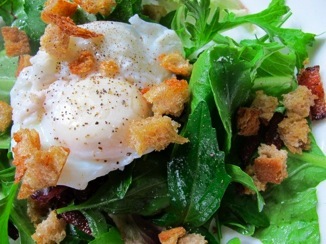 So folks are embracing “Meatless Mondays” – from L.A. Mayor Antonio Villaraigosa (maybe he’s also embracing meatless policies) to celebrity chef Mario Battali (who might consider some meal-less mondays – I know, I know, who am I to talk), but what about “Meatless Mostdays?” That’s what’s getting embraced around my house,
So folks are embracing “Meatless Mondays” – from L.A. Mayor Antonio Villaraigosa (maybe he’s also embracing meatless policies) to celebrity chef Mario Battali (who might consider some meal-less mondays – I know, I know, who am I to talk), but what about “Meatless Mostdays?” That’s what’s getting embraced around my house,
Chalk it up to my trying to “live off our land” or to me being too tired to go to the market, we’ve been eating eggs, not meat, for dinner. To make the eggs-seem-special-for-dinner, I have been serving them poached. Poached eggs are fancier than fried eggs – the delicate cooking results in tender whites and creamy, pudding-like yolks. I’ve served poached eggs with salad, croutons and bacon, poached eggs on root vegetable hash, poached eggs and Serrano jamon on toast with grilled green onion, arugula and Romesco sauce, poached eggs on whole wheat pasta with whole wheat bread crumbs and Swiss chard. (Yes, I know – there is bacon and Spanish ham in these dishes--so maybe Mostly Meatless Mostdays? – Is that better?)

 During my first fall as a single person, I started eating fried fish
for dinner a few nights a week. I cooked it with ingredients I bought
at M2M, a Korean bodega across the street from my apartment building in
the East Village. M2M sold three types of fish: salmon, sole, and basa.
The salmon was bright orange and fat, the sole was thin and yellow with
odd raised bumps like pores, and the basa was light pink and
smooth-fleshed. I have a bourgeois distaste for salmon stemming from a
childhood vacation to France where it had was served at nearly every
meal, and I feared the wan, pebbly sole. So I always bought the basa,
despite the fact that before moving across the street from M2M I had
never heard of this fish.
During my first fall as a single person, I started eating fried fish
for dinner a few nights a week. I cooked it with ingredients I bought
at M2M, a Korean bodega across the street from my apartment building in
the East Village. M2M sold three types of fish: salmon, sole, and basa.
The salmon was bright orange and fat, the sole was thin and yellow with
odd raised bumps like pores, and the basa was light pink and
smooth-fleshed. I have a bourgeois distaste for salmon stemming from a
childhood vacation to France where it had was served at nearly every
meal, and I feared the wan, pebbly sole. So I always bought the basa,
despite the fact that before moving across the street from M2M I had
never heard of this fish.  I had the world's strangest roommate. We were best friends in college
and she seemed like the perfect person to live with. She was a great
listener, she was obsessed with Clive Owen and her purse was always
stocked with remedies to just about anything – creams, lotions, pills,
even powders. Everything was going great, until one day, it just
wasn't. Her once mild room-dancing had started to rival the sound of a
herd of elephants, her attempts to match our outfits had turned from
sort of cute to sort of single-white-female (except that she's five
feet tall and Asian) and she had invited her new best friend to come
live with us for a month, without consulting me. She finally decided to
move out, taking her friend with her. And they went amicably enough.
I had the world's strangest roommate. We were best friends in college
and she seemed like the perfect person to live with. She was a great
listener, she was obsessed with Clive Owen and her purse was always
stocked with remedies to just about anything – creams, lotions, pills,
even powders. Everything was going great, until one day, it just
wasn't. Her once mild room-dancing had started to rival the sound of a
herd of elephants, her attempts to match our outfits had turned from
sort of cute to sort of single-white-female (except that she's five
feet tall and Asian) and she had invited her new best friend to come
live with us for a month, without consulting me. She finally decided to
move out, taking her friend with her. And they went amicably enough. The flame war between charcoal grill purists and gas grill hotheads
burns brighter than the debate between Mac and PC users. You should
read some of the slop slung on the barbecue message boards. On second
thought, don't. Let me try to sort it out for you with a few
inflammatory thoughts.
The flame war between charcoal grill purists and gas grill hotheads
burns brighter than the debate between Mac and PC users. You should
read some of the slop slung on the barbecue message boards. On second
thought, don't. Let me try to sort it out for you with a few
inflammatory thoughts.
 I am a Toaster Oven Top Chef. I’m by no means a professional like the wunderkinder you see on Bravo’s reality TV cooking showdown. I don’t have a fully stocked kitchen. I only own four knives. And although
technically my kitchen has a real oven, it’s so marred with
unidentifiable char no amount of Easy Off cleaning products could
restore it to a serviceable condition. What I do have is the heart of a
champion, and the spirit of a competitor.
I am a Toaster Oven Top Chef. I’m by no means a professional like the wunderkinder you see on Bravo’s reality TV cooking showdown. I don’t have a fully stocked kitchen. I only own four knives. And although
technically my kitchen has a real oven, it’s so marred with
unidentifiable char no amount of Easy Off cleaning products could
restore it to a serviceable condition. What I do have is the heart of a
champion, and the spirit of a competitor. 